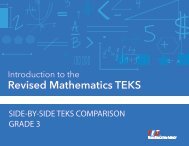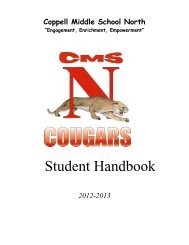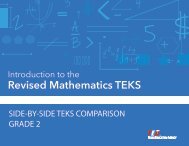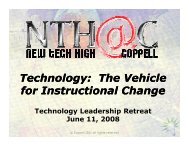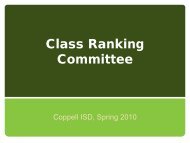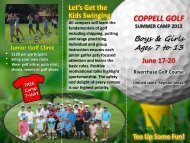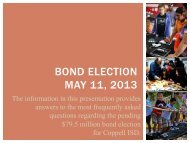K-Algebra I - Coppell Independent School District
K-Algebra I - Coppell Independent School District
K-Algebra I - Coppell Independent School District
Create successful ePaper yourself
Turn your PDF publications into a flip-book with our unique Google optimized e-Paper software.
©2013 Texas Education Agency. All Rights Reserved 2013 Introduction to the Revised Mathematics TEKS: Vertical Alignment Chart Kindergarten – <strong>Algebra</strong> I 1
The materials are copyrighted (c) and trademarked (tm) as the property of the Texas Education Agency (TEA) and may not be reproduced without the express written permission of TEA, exceptunder the following conditions:Texas public school districts, charter schools, and Education Service Centers may reproduce and use copies of the Materials and Related Materials for the districts’ and schools’ educational usewithout obtaining permission from TEA.Residents of the state of Texas may reproduce and use copies of the Materials and Related Materials for individual personal use only without obtaining written permission of TEA.Any portion reproduced must be reproduced in its entirety and remain unedited, unaltered and unchanged in any way.No monetary charge can be made for the reproduced materials or any document containing them; however, a reasonable charge to cover only the cost of reproduction and distribution may becharged.Private entities or persons located in Texas that are not Texas public school districts, Texas Education Service Centers, or Texas charter schools or any entity, whether public or private, educationalor non-educational, located outside the state of Texas MUST obtain written approval from TEA and will be required to enter into a license agreement that may involve the payment of a licensing fee ora royalty.For information contact:Office of Copyrights, Trademarks, License Agreements, and Royalties,Texas Education Agency,1701 N. Congress Ave., Austin, TX 78701-1494;phone: 512-463-9270 or 512-463-9437;email: copyrights@tea.state.tx.us.©2013 Texas Education Agency All Rights Reserved 2013©2013 Texas Education Agency. All Rights Reserved 2013 Introduction to the Revised Mathematics TEKS: Vertical Alignment Chart Kindergarten – <strong>Algebra</strong> I 2
Kindergarten Grade 1 Grade 2 Grade 3 Grade 4 Grade 5 Grade 6 Grade 7 Grade 8 <strong>Algebra</strong> I(1) Mathematical process standards. The student uses mathematical processes to acquire and demonstrate mathematical understanding. The student is expected to:(A) apply mathematics to problems arising in everyday life, society, and the workplace.(B) use a problem‐solving model that incorporates analyzing given information, formulating a plan or strategy, determining a solution, justifying the solution, and evaluating the problem‐solving process and the reasonableness ofthe solution.(C) select tools, including real objects, manipulatives, paper and pencil, and technology as appropriate, and techniques, including mental math, estimation, and number sense as appropriate, to solve problems.(D) communicate mathematical ideas, reasoning, and their implications using multiple representations, including symbols, diagrams, graphs, and language as appropriate.(E) create and use representations to organize, record, and communicate mathematical ideas.(F) analyze mathematical relationships to connect and communicate mathematical ideas.(G) display, explain, and justify mathematical ideas and arguments using precise mathematical language in written or oral communication.©2013 Texas Education Agency. All Rights Reserved 2013 Introduction to the Revised Mathematics TEKS: Vertical Alignment Chart Kindergarten – <strong>Algebra</strong> I 3
Kindergarten Grade 1 Grade 2 Grade 3 Grade 4 Grade 5 Grade 6 Grade 7 Grade 8 <strong>Algebra</strong> IComposing and Decomposing Numbers: Place Value(2) Number and operations.The student appliesmathematical processstandards to understandhow to represent andcompare whole numbers,the relative position andmagnitude of wholenumbers, and relationshipswithin the numerationsystem. The student isexpected to:(I) compose and decomposenumbers up to 10 withobjects and pictures.(2) Number and operations.The student appliesmathematical processstandards to represent andcompare whole numbers,the relative position andmagnitude of wholenumbers, and relationshipswithin the numerationsystem related to placevalue. The student isexpected to:(B) use concrete andpictorial models to composeand decomposenumbers up to 120 in morethan one way as so manyhundreds, so many tens, andso many ones.(C) use objects, pictures, andexpanded and standardforms to represent numbersup to 120.(2) Number and operations.The student appliesmathematical processstandards to understandhow to represent andcompare whole numbers,the relative position andmagnitude of wholenumbers, and relationshipswithin the numerationsystem related to placevalue. The student isexpected to:(A) use concrete andpictorial models to composeand decomposenumbers up to 1,200 in morethan one way as a sum of somany thousands, hundreds,tens, and ones.(B) use standard, word, andexpanded formsto represent numbers up to1,200.(2) Number and operations.The student appliesmathematical processstandards to represent andcompare whole numbers andunderstand relationshipsrelated to place value. Thestudent is expected to:(A) compose anddecompose numbers up to100,000 as a sum of so manyten thousands, so manythousands, so manyhundreds, so many tens, andso many ones using objects,pictorial models, andnumbers, includingexpanded notation asappropriate.(B) describe themathematical relationshipsfound in the base‐10 placevalue system through thehundred thousands place.(2) Number and operations.The student appliesmathematical processstandards to represent,compare, and order wholenumbers and decimals andunderstand relationshipsrelated to place value. Thestudent is expected to:(B) represent the value ofthe digit in whole numbersthrough 1,000,000,000 anddecimals to the hundredthsusing expanded notation andnumerals.(A) interpret the value ofeach place‐value position as10 times the position to theright and as one‐tenth of thevalue of the place to its left.(E) represent decimals,including tenths andhundredths, using concreteand visual models andmoney.(2) Number and operations.The student appliesmathematical processstandards to represent,compare, and order positiverational numbers andunderstand relationships asrelated to place value. Thestudent is expected to:(A) represent the value ofthe digit in decimals throughthe thousandths usingexpanded notation andnumerals.(2) Number and operations.The student appliesmathematical processstandards to represent anduse real numbers in a varietyof forms. The student isexpected to:(C) convert betweenstandard decimal notationand scientific notation.©2013 Texas Education Agency. All Rights Reserved 2013 Introduction to the Revised Mathematics TEKS: Vertical Alignment Chart Kindergarten – <strong>Algebra</strong> I 7
Kindergarten Grade 1 Grade 2 Grade 3 Grade 4 Grade 5 Grade 6 Grade 7 Grade 8 <strong>Algebra</strong> IRepresenting Fraction Concepts(3) Number and operations.The student appliesmathematical processstandards to recognize andrepresent fractional unitsand communicates how theyare used to name parts of awhole. The student isexpected to:(A) partition objects intoequal parts and name theparts, including halves,fourths, and eighths, usingwords.(D) identify examples andnon‐examples of halves,fourths, and eighths.(C) use concrete models tocount fractional partsbeyond one whole usingwords and recognize howmany parts it takes to equalone whole.(B) explain that the morefractional parts used to makea whole, the smaller thepart. the fewer the fractionalparts, the larger the part.(3) Number and operations.The student appliesmathematical processstandards to represent andexplain fractional units. Thestudent is expected to:(A) represent fractionsgreater than zero and lessthan or equal to one withdenominators of 2, 3, 4, 6, and8 using concrete objects andpictorial models, includingstrip diagrams and numberlines.(E) solve problems involvingpartitioning an object or aset of objects among two ormore recipients usingpictorial representations offractions with denominatorsof 2, 3, 4, 6, and 8.(C) explain that the unitfraction 1/b represents thequantity formed by one partof a whole that has beenpartitioned into b equal partswhere b is a non‐zero wholenumber.(D) compose anddecompose afraction a/b with anumerator greater than zeroand less than or equal to b asa sum of parts 1/b.(3) Number and operations.The student appliesmathematical processstandards to represent andgenerate fractions to solveproblems. The student isexpected to:(A) represent afraction a/b as a sum offractions 1/b,where a and b are wholenumbers and b > 0, includingwhen a > b.(B) decompose a fraction inmore than one way into asum of fractions with thesame denominator usingconcrete and pictorialmodels and recording resultswith symbolicrepresentations.(G) represent fractions anddecimals to the tenths orhundredths as distancesfrom zero on a number line.(2) Number and operations.The student appliesmathematical processstandards to represent anduse rational numbers in avariety of forms. The studentis expected to:(E) extend representationsfor division to includefraction notation such as a/brepresents the same numberas a ÷ b where b ≠ 0.©2013 Texas Education Agency. All Rights Reserved 2013 Introduction to the Revised Mathematics TEKS: Vertical Alignment Chart Kindergarten – <strong>Algebra</strong> I 8
Kindergarten Grade 1 Grade 2 Grade 3 Grade 4 Grade 5 Grade 6 Grade 7 Grade 8 <strong>Algebra</strong> IDetermining Equivalence and Comparing Part‐to‐Whole Relationships(3) Number and operations.The student appliesmathematical processstandards to represent andexplain fractional units. Thestudent is expected to:(F) represent equivalentfractions with denominatorsof 2, 3, 4, 6, and 8 using avariety of objects andpictorial models, includingnumber lines.(G) explain that twofractions are equivalent ifand only if they are bothrepresented by the samepoint on the number lineor represent the sameportion of a same size wholefor an area model.(H) compare two fractionshaving the same numeratoror denominator in problemsby reasoning about theirsizes and justifying theconclusion using symbols,words, objects, and pictorialmodels.(3) Number and operations.The student appliesmathematical processstandards to represent andgenerate fractions to solveproblems. The student isexpected to:(C) determine if two givenfractions are equivalentusing a variety of methods.(D) compare two fractionswith different numeratorsand different denominatorsand represent thecomparison using thesymbols >, =, or
Kindergarten Grade 1 Grade 2 Grade 3 Grade 4 Grade 5 Grade 6 Grade 7 Grade 8 <strong>Algebra</strong> IAdding and Subtracting Whole Numbers, Decimals, and Rational Numbers(3) Number and operations.The student appliesmathematical processstandards to develop anunderstanding of additionand subtraction situations inorder to solve problems. Thestudent is expected to:(A) model the action ofjoining to represent additionand the action of separatingto represent subtraction.(B) solve word problemsusing objects and drawingsto find sums up to 10 anddifferences within 10.(C) explain the strategiesused to solve problemsinvolvingadding and subtractingwithin 10 using spokenwords, concrete and pictorialmodels, and numbersentences.(3) Number and operations.The student appliesmathematical processstandards to develop and usestrategies for whole numberaddition and subtractioncomputations in order tosolve problems. The studentis expected to:(B) use objects and pictorialmodelsto solve word problemsinvolving joining, separating,and comparing sets within 20and unknowns as any one ofthe terms in theproblem such as 2 + 4 = [ ];3 + [ ] = 7; and 5 = [ ] ‐ 3.(C) compose 10 with two ormore addends with andwithout concrete objects.(E) explain strategies used tosolve addition andsubtraction problems upto 20 using spoken words,objects, pictorial models, andnumber sentences.(A) use concrete andpictorial models todetermine the sum of amultiple of 10 and a onedigitnumber in problems upto 99.(D) apply basic factstrategies to add andsubtract within 20, includingmaking 10 and decomposinga number leading to a 10.(F) generate andsolve problem situationswhen given a numbersentence involving additionor subtraction of numberswithin 20.(4) Number and operations.The student appliesmathematical processstandards to develop and usestrategies and methods forwhole number computationsin order to solve additionand subtraction problemswith efficiency and accuracy.The student is expected to:(B) add up to four two‐digitnumbers and subtract twodigitnumbers using mentalstrategies and algorithmsbased on knowledge of placevalue and properties ofoperations.(C) solve one‐step and multistepword problemsinvolving addition andsubtraction within 1,000using a variety of strategiesbased on placevalue, including algorithms.(A) recall basic facts to addand subtract within 20 withautomaticity.(D) generate andsolve problem situations fora given mathematicalnumber sentenceinvolving addition andsubtraction of wholenumbers within 1,000.(4) Number and operations.The student appliesmathematical processstandards to develop and usestrategies and methods forwhole number computationsin order to solve problemswith efficiency and accuracy.The student is expected to:(A) solve with fluency onestepand two‐step problemsinvolving addition andsubtraction within 1,000using strategies based onplace value, properties ofoperations, and therelationship betweenaddition and subtraction.(4) Number and operations.The student appliesmathematical processstandards to develop and usestrategies and methods forwhole number computationsand decimal sums anddifferences in order to solveproblems with efficiency andaccuracy. The student isexpected to:(A) add and subtract wholenumbers and decimals to thehundredths place using thestandard algorithm.(3) Number and operations.The student appliesmathematical processstandards to develop anduse strategies and methodsfor positive rational numbercomputations in order tosolve problems withefficiency and accuracy. Thestudent is expected to:(A) estimate to determinesolutions to mathematicaland real‐world problemsinvolving addition,subtraction, multiplication,or division.3) Number and operations.The student appliesmathematical processstandards to add, subtract,multiply, and divide whilesolving problems andjustifying solutions. Thestudent is expected to:(A) add, subtract, multiply,and divide rational numbersfluently.(B) apply and extendprevious understandings ofoperations to solve problemsusing addition, subtraction,multiplication, and divisionof rational numbers©2013 Texas Education Agency. All Rights Reserved 2013 Introduction to the Revised Mathematics TEKS: Vertical Alignment Chart Kindergarten – <strong>Algebra</strong> I 10
Kindergarten Grade 1 Grade 2 Grade 3 Grade 4 Grade 5 Grade 6 Grade 7 Grade 8 <strong>Algebra</strong> IAdding and Subtracting Fractions and Rational Numbers(3) Number and operations.The student appliesmathematical processstandards to represent andgenerate fractions to solveproblems. The student isexpected to:(E) represent and solveaddition and subtraction offractions with equaldenominators using objectsand pictorial models thatbuild to the number line andproperties of operations.(F) evaluate thereasonableness of sums anddifferences of fractions usingbenchmark fractions 0, 1/4,1/2, 3/4, and 1, referring tothe same whole.(3) Number and operations.The student appliesmathematical processstandards to develop and usestrategies and methods forpositive rational numbercomputations in order tosolve problems withefficiency and accuracy. Thestudent is expected to:(H) represent and solveaddition and subtraction offractions with unequaldenominators referring tothe same whole usingobjects and pictorial modelsand properties of operations.(K) add and subtract positiverational numbers fluently.(3) Number andoperations. The studentapplies mathematicalprocess standards to add,subtract, multiply, and dividewhile solving problems andjustifying solutions. Thestudent is expected to:(B) apply and extendprevious understandings ofoperations to solve problemsusing addition, subtraction,multiplication, and divisionof rational numbers(A) add, subtract, multiply,and divide rational numbersfluently.©2013 Texas Education Agency. All Rights Reserved 2013 Introduction to the Revised Mathematics TEKS: Vertical Alignment Chart Kindergarten – <strong>Algebra</strong> I 11
Kindergarten Grade 1 Grade 2 Grade 3 Grade 4 Grade 5 Grade 6 Grade 7 Grade 8 <strong>Algebra</strong> IApplying Strategies for Estimation(4) Number and operations.The student appliesmathematical processstandards to develop and usestrategies and methods forwhole number computationsin order to solve problemswith efficiency and accuracy.The student is expected to:(B) round to the nearest 10or 100 or use compatiblenumbers to estimatesolutions to addition andsubtraction problems.(2) Number and operations.The student appliesmathematical processstandards to represent,compare, and order wholenumbers and decimals andunderstand relationshipsrelated to place value. Thestudent is expected to:(D) round whole numbers toa given place value throughthe hundred thousandsplace.(4) Number and operations.The student appliesmathematical processstandards to develop and usestrategies and methods forwhole number computationsand decimal sums anddifferences in order to solveproblems with efficiency andaccuracy. The student isexpected to:(G) round to the nearest 10,100, or 1,000 or usecompatible numbers toestimate solutions involvingwhole numbers.(2) Number and operations.The student appliesmathematical processstandards to represent,compare, and order positiverational numbers andunderstand relationships asrelated to place value. Thestudent is expected to:(C) round decimals to tenthsor hundredths.Kindergarten Grade 1 Grade 2 Grade 3 Grade 4 Grade 5 Grade 6 Grade 7 Grade 8 <strong>Algebra</strong> IRepresenting and Determining Values of Coins and Bills(4) Number and operations.The student appliesmathematical processstandards to identify coins inorder to recognize the needfor monetary transactions.The student is expected to:(A) identify U.S. coins byname, including pennies,nickels, dimes, and quarters.(4) Number and operations.The student appliesmathematical processstandards to identify coins,their values, and therelationships among them inorder to recognize the needfor monetary transactions.The student is expected to:(A) identify U.S. coins,including pennies, nickels,dimes, and quarters, byvalue and describe therelationships among them.(B) write a number with thecent symbol to describe thevalue of a coin.(C) use relationshipsto count by twos, fives, andtens to determine the valueof a collection of pennies,nickels, and/or dimes.(5) Number andoperations. The studentapplies mathematicalprocess standards todetermine the value of coinsin order to solve monetarytransactions. The student isexpected to:(B) use the cent symbol,dollar sign, and the decimalpoint to name the value of acollection of coins.(A) determine the value of acollection of coins up to onedollar.(4) Number and operations.The student appliesmathematical processstandards to develop and usestrategies and methods forwhole number computationsin order to solve problemswith efficiency and accuracy.The student is expected to:(C) determine the value of acollection of coins and bills.©2013 Texas Education Agency. All Rights Reserved 2013 Introduction to the Revised Mathematics TEKS: Vertical Alignment Chart Kindergarten – <strong>Algebra</strong> I 12
Kindergarten Grade 1 Grade 2 Grade 3 Grade 4 Grade 5 Grade 6 Grade 7 Grade 8 <strong>Algebra</strong> IMultiplying Whole Numbers, Decimals, Fractions, and Rational Numbers(6) Number and operations.The student appliesmathematical processstandards to connectrepeated addition andsubtraction to multiplicationand division situations thatinvolve equal groupings andshares. The student isexpected to:(A) model, create, anddescribe contextualmultiplication situations inwhich equivalent sets ofconcrete objects are joined.(4) Number and operations.The student appliesmathematical processstandards to develop and usestrategies and methods forwhole number computationsin order to solve problemswith efficiency and accuracy.The student is expected to:(D) determine the totalnumber of objects whenequally‐sized groups ofobjects are combined orarranged in arrays up to 10by 10.(E) represent multiplicationfacts by using a variety ofapproaches such as repeatedaddition, equal‐sized groups,arrays, area models, equaljumps on a number line, andskip counting.(F) recall facts to multiply upto 10 by 10 with automaticityand recall the correspondingdivision facts.(G) use strategies andalgorithms, including thestandard algorithm, tomultiply a two‐digit numberby a one‐digit number.Strategies may includemental math, partialproducts, and thecommutative, associative,and distributive properties.(4) Number and operations.The student appliesmathematical processstandards to develop and usestrategies and methods forwhole number computationsand decimal sums anddifferences in order to solveproblems with efficiency andaccuracy. The student isexpected to:(B) determine products of anumber and 10 or 100 usingproperties of operations andplace value understandings.(C) represent the product of2 two‐digit numbers usingarrays, area models, orequations, including perfectsquares through 15 by 15.(D) use strategies andalgorithms, including thestandard algorithm, tomultiply up to a four‐digitnumber by a one‐digitnumber and to multiply atwo‐digit number by a twodigitnumber. Strategies mayinclude mental math, partialproducts, and thecommutative, associative,and distributive properties.(H) solve with fluency oneandtwo‐step problemsinvolving multiplication anddivision, includinginterpreting remainders.(3) Number and operations.The student appliesmathematical processstandards to develop anduse strategies and methodsfor positive rational numbercomputations in order tosolve problems withefficiency and accuracy. Thestudent is expected to:(B) multiply with fluency athree‐digit number by a twodigitnumber using thestandard algorithm.(D) represent multiplicationof decimals with products tothe hundredths using objectsand pictorial models,including area models.(3) Number and operations.The student appliesmathematical processstandards to representaddition, subtraction,multiplication, and divisionwhile solving problems andjustifying solutions. Thestudent is expected to:(E) multiply and dividepositive rational numbersfluently.3) Number and operations.The student appliesmathematical processstandards to add, subtract,multiply, and divide whilesolving problems andjustifying solutions. Thestudent is expected to:(A) add, subtract, multiply,and divide rational numbersfluently.(B) apply and extendprevious understandings ofoperations to solve problemsusing addition, subtraction,multiplication, and divisionof rational numbers©2013 Texas Education Agency. All Rights Reserved 2013 Introduction to the Revised Mathematics TEKS: Vertical Alignment Chart Kindergarten – <strong>Algebra</strong> I 13
Kindergarten Grade 1 Grade 2 Grade 3 Grade 4 Grade 5 Grade 6 Grade 7 Grade 8 <strong>Algebra</strong> IMultiplying Whole Numbers, Decimals, Fractions, and Rational Numbers(6) Number and operations.The student appliesmathematical processstandards to connectrepeated addition andsubtraction to multiplicationand division situations thatinvolve equal groupings andshares. The student isexpected to:(4) Number and operations.The student appliesmathematical processstandards to develop and usestrategies and methods forwhole number computationsin order to solve problemswith efficiency and accuracy.The student is expected to:(4) Number and operations.The student appliesmathematical processstandards to develop and usestrategies and methods forwhole number computationsand decimal sums anddifferences in order to solveproblems with efficiency andaccuracy. The student isexpected to:(3) Number and operations.The student appliesmathematical processstandards to develop anduse strategies and methodsfor positive rational numbercomputations in order tosolve problems withefficiency and accuracy. Thestudent is expected to:(E) solve for products ofdecimals to the hundredths,including situations involvingmoney, using strategiesbased on place‐valueunderstandings, propertiesof operations, and therelationship to themultiplication of wholenumbers.(I) represent and solvemultiplication of a wholenumber and a fraction thatrefers to the same wholeusing objects and pictorialmodels, including areamodels.(3) Number and operations.The student appliesmathematical processstandards to representaddition, subtraction,multiplication, and divisionwhile solving problems andjustifying solutions. Thestudent is expected to:E) multiply and dividepositive rational numbersfluently.(B) determine, with andwithout computation,whether a quantity isincreased or decreased whenmultiplied by a fraction,including values greater thanor less than one.3) Number and operations.The student appliesmathematical processstandards to add, subtract,multiply, and divide whilesolving problems andjustifying solutions. Thestudent is expected to:(B) apply and extendprevious understandings ofoperations to solve problemsusing addition, subtraction,multiplication, and divisionof rational numbers.©2013 Texas Education Agency. All Rights Reserved 2013 Introduction to the Revised Mathematics TEKS: Vertical Alignment Chart Kindergarten – <strong>Algebra</strong> I 14
Kindergarten Grade 1 Grade 2 Grade 3 Grade 4 Grade 5 Grade 6 Grade 7 Grade 8 <strong>Algebra</strong> IDividing Whole Numbers, Decimals, Fractions, and Rational Numbers(6) Number and operations.The student appliesmathematical processstandards to connectrepeated addition andsubtraction to multiplicationand division situations thatinvolve equal groupings andshares. The student isexpected to:(B) model, create, anddescribe contextual divisionsituations in which a set ofconcrete objects is separatedinto equivalent sets.(4) Number and operations.The student appliesmathematical processstandards to develop and usestrategies and methods forwhole number computationsin order to solve problemswith efficiency and accuracy.The student is expected to:(H) determine the numberof objects in each groupwhen a set of objects ispartitioned into equal sharesor a set of objects is sharedequally.(I) determine if a number iseven or odd using divisibilityrules.(J) determine a quotientusing the relationshipbetween multiplication anddivision.(K) solve one‐step and twostepproblems involvingmultiplication and divisionwithin 100 using strategiesbased on objects; pictorialmodels, including arrays,area models, and equalgroups; properties ofoperations; or recall of facts.(4) Number and operations.The student appliesmathematical processstandards to develop and usestrategies and methods forwhole number computationsand decimal sums anddifferences in order to solveproblems with efficiency andaccuracy. The student isexpected to:(E) represent the quotient ofup to a four‐digit wholenumber divided by a onedigitwhole number usingarrays, area models, orequations.(F) use strategies andalgorithms, including thestandard algorithm, to divideup to a four‐digit dividend bya one‐digit divisor.(H) solve with fluency oneandtwo‐step problemsinvolving multiplication anddivision, includinginterpreting remainders.(3) Number and operations.The student appliesmathematical processstandards to develop and usestrategies and methods forpositive rational numbercomputations in order tosolve problems withefficiency and accuracy. Thestudent is expected to:(C) solve with proficiency forquotients of up to a fourdigitdividend by a two‐digitdivisor using strategies andthe standard algorithm.(F) represent quotients ofdecimals to the hundredths,up to four‐digit dividendsand two‐digit whole numberdivisors, using objects andpictorial models, includingarea models.(G) solve for quotients ofdecimals to the hundredths,up to four‐digit dividendsand two‐digit whole numberdivisors, using strategies andalgorithms, including thestandard algorithm.(3) Number and operations.The student appliesmathematical processstandards to representaddition, subtraction,multiplication, and divisionwhile solving problems andjustifying solutions. Thestudent is expected to:(A) recognize that dividing bya rational number andmultiplying by its reciprocalresult in equivalent values.(E) multiply and dividepositive rational numbersfluently.3) Number and operations.The student appliesmathematical processstandards to add, subtract,multiply, and divide whilesolving problems andjustifying solutions. Thestudent is expected to:(A) add, subtract, multiply,and divide rational numbersfluently.(B) apply and extendprevious understandings ofoperations to solve problemsusing addition, subtraction,multiplication, and divisionof rational numbers©2013 Texas Education Agency. All Rights Reserved 2013 Introduction to the Revised Mathematics TEKS: Vertical Alignment Chart Kindergarten – <strong>Algebra</strong> I 15
Kindergarten Grade 1 Grade 2 Grade 3 Grade 4 Grade 5 Grade 6 Grade 7 Grade 8 <strong>Algebra</strong> IDividing Whole Numbers, Decimals, Fractions, and Rational Numbers(6) Number and operations.The student appliesmathematical processstandards to connectrepeated addition andsubtraction to multiplicationand division situations thatinvolve equal groupings andshares. The student isexpected to:(4) Number and operations.The student appliesmathematical processstandards to develop and usestrategies and methods forwhole number computationsin order to solve problemswith efficiency and accuracy.The student is expected to:(4) Number and operations.The student appliesmathematical processstandards to develop and usestrategies and methods forwhole number computationsand decimal sums anddifferences in order to solveproblems with efficiency andaccuracy. The student isexpected to:(3) Number and operations.The student appliesmathematical processstandards to develop and usestrategies and methods forpositive rational numbercomputations in order tosolve problems withefficiency and accuracy. Thestudent is expected to:(J) represent division of aunit fraction by a wholenumber and the division of awhole number by a unitfraction such as 1/3 ÷ 7 and 7÷ 1/3 using objects andpictorial models, includingarea models.(L) divide whole numbers byunit fractions and unitfractions by whole numbers.(3) Number and operations.The student appliesmathematical processstandards to representaddition, subtraction,multiplication, and divisionwhile solving problems andjustifying solutions. Thestudent is expected to:(E) multiply and dividepositive rational numbersfluently.3) Number and operations.The student appliesmathematical processstandards to add, subtract,multiply, and divide whilesolving problems andjustifying solutions. Thestudent is expected to:(A) add, subtract, multiply,and divide rational numbersfluently.(B) apply and extendprevious understandings ofoperations to solve problemsusing addition, subtraction,multiplication, and divisionof rational numbers.Applying Operations with Integers andRational Numbers(3) Number and operations.The student appliesmathematical processstandards to representaddition, subtraction,multiplication, and divisionwhile solving problems andjustifying solutions. Thestudent is expected to:(C) represent integeroperations with concretemodels and connect theactions with the models tostandardized algorithms.(D) add, subtract, multiply,and divide integers fluently.(E) multiply and dividepositive rational numbersfluently.3) Number and operations.The student appliesmathematical processstandards to add, subtract,multiply, and divide whilesolving problems andjustifying solutions. Thestudent is expected to:(A) add, subtract, multiply,and divide rational numbersfluently.(B) apply and extendprevious understandings ofoperations to solve problemsusing addition, subtraction,multiplication, and divisionof rational numbers.©2013 Texas Education Agency. All Rights Reserved 2013 Introduction to the Revised Mathematics TEKS: Vertical Alignment Chart Kindergarten – <strong>Algebra</strong> I 16
Kindergarten Grade 1 Grade 2 Grade 3 Grade 4 Grade 5 Grade 6 Grade 7 Grade 8 <strong>Algebra</strong> IConnecting Counting and Reciting(5) <strong>Algebra</strong>ic reasoning. Thestudent applies mathematicalprocess standards to identifythe pattern in the numberword list. The student isexpected to:(A) recite numbers up to atleast 100 by ones and tensbeginning with any givennumber.(5) <strong>Algebra</strong>ic reasoning. Thestudent appliesmathematical processstandards to identify andapply number patternswithin properties of numbersand operations in order todescribe relationships. Thestudent is expected to:(A) recite numbers forwardand backward from anygiven number between 1 and120.(5) <strong>Algebra</strong>ic reasoning. Thestudent appliesmathematical processstandards to identify andapply number patternswithin properties of numbersand operations in order todescribe relationships. Thestudent is expected to:(B) skip count by twos, fives,and tens to determine thetotal number of objects upto 120 in a set.(7) <strong>Algebra</strong>ic reasoning. Thestudent appliesmathematical processstandards to identify andapply number patternswithin properties of numbersand operations in order todescribe relationships. Thestudent is expected to:(A) determine whether anumber up to 40 is even orodd using pairings of objectsto represent the number.Connecting Counting and Place Value(5) <strong>Algebra</strong>ic reasoning. Thestudent appliesmathematical processstandards to identify andapply number patternswithin properties of numbersand operations in order todescribe relationships. Thestudent is expected to:(C) use relationshipsto determine the numberthat is 10 more and 10 lessthan a given number up to120.(7) <strong>Algebra</strong>ic reasoning. Thestudent appliesmathematical processstandards to identify andapply number patternswithin properties of numbersand operations in order todescribe relationships. Thestudent is expected to:(B) use an understanding ofplace value to determine thenumber that is 10 or 100more or less than a givennumber up to 1,200.Connecting Counting and Divisibility(5) <strong>Algebra</strong>ic reasoning. Thestudent appliesmathematical processstandards to analyze andcreate patterns andrelationships. The student isexpected to:(5) <strong>Algebra</strong>ic reasoning. Thestudent appliesmathematical processstandards to developconcepts of expressions andequations. The student isexpected to:(4) <strong>Algebra</strong>ic reasoning. Thestudent appliesmathematical processstandards to developconcepts of expressions andequations. The student isexpected to:(A) identify prime andcomposite numbers.©2013 Texas Education Agency. All Rights Reserved 2013 Introduction to the Revised Mathematics TEKS: Vertical Alignment Chart Kindergarten – <strong>Algebra</strong> I 17
Kindergarten Grade 1 Grade 2 Grade 3 Grade 4 Grade 5 Grade 6 Grade 7 Grade 8 <strong>Algebra</strong> IRepresenting Problem Situations with the Equal Sign(5) <strong>Algebra</strong>ic reasoning. Thestudent appliesmathematical processstandards to identify andapply number patternswithin properties of numbersand operations in order todescribe relationships. Thestudent is expected to:(D) represent wordproblems involving additionand subtraction of wholenumbers up to 20 usingconcrete and pictorialmodels and numbersentences.(E) understand that theequal sign represents arelationship whereexpressions on each side ofthe equal sign represent thesame value(s).(7) <strong>Algebra</strong>ic reasoning. Thestudent appliesmathematical processstandards to identify andapply number patternswithin properties of numbersand operations in order todescribe relationships. Thestudent is expected to:(C) represent and solveaddition and subtractionword problems whereunknowns may be any one ofthe terms in the problem.(5) <strong>Algebra</strong>ic reasoning. Thestudent appliesmathematical processstandards to analyze andcreate patterns andrelationships. The student isexpected to:(A) represent one‐ and twostepproblems involvingaddition and subtraction ofwhole numbers to 1,000using pictorial models,number lines, and equations.(B) represent and solve oneandtwo‐step multiplicationand division problems within100 using arrays, stripdiagrams, and equations.(5) <strong>Algebra</strong>ic reasoning. Thestudent appliesmathematical processstandards to developconcepts of expressions andequations. The student isexpected to:(A) represent multi‐stepproblems involving the fouroperations with wholenumbers using stripdiagrams and equations witha letter standing for theunknown quantity.(4) <strong>Algebra</strong>ic reasoning. Thestudent appliesmathematical processstandards to developconcepts of expressions andequations. The student isexpected to:(B) represent and solvemulti‐step problemsinvolving the four operationswith whole numbers usingequations with a letterstanding for the unknownquantity.(7) Expressions, equations,and relationships. Thestudent appliesmathematical processstandards to developconcepts of expressions andequations. The student isexpected to:(B) distinguish betweenexpressions and equationsverbally, numerically, andalgebraically.Representing Problem Situations with Equations and Inequalities(9) Expressions, equations,and relationships. Thestudent appliesmathematical processstandards to use equationsand inequalities to representsituations. The student isexpected to:(A) write one‐variable, onestepequations andinequalities to representconstraints or conditionswithin problems.(B) represent solutions forone‐variable, one‐stepequations and inequalitieson number lines.(C) write corresponding realworldproblems given onevariable,one‐step equationsor inequalities.(10) Expressions, equations,and relationships. Thestudent appliesmathematical processstandards to use onevariableequations andinequalities to representsituations. The student isexpected to:(A) write one‐variable, twostepequations andinequalities to representconstraints or conditionswithin problems.(B) represent solutions forone‐variable, two‐stepequations and inequalitieson number lines.(C) write a correspondingreal‐world problem given aone‐variable, two‐stepequation or inequality.(8) Expressions, equations,and relationships. Thestudent appliesmathematical processstandards to use onevariableequations orinequalities in problemsituations. The student isexpected to:(A) write onevariableequations orinequalities with variables onboth sides thatrepresent problemsusing rational numbercoefficients and constants.(B) write a correspondingreal‐world problem whengiven a one‐variableequation or inequality withvariables on both sides of theequal sign using rationalnumber coefficients andconstants.©2013 Texas Education Agency. All Rights Reserved 2013 Introduction to the Revised Mathematics TEKS: Vertical Alignment Chart Kindergarten – <strong>Algebra</strong> I 18
Kindergarten Grade 1 Grade 2 Grade 3 Grade 4 Grade 5 Grade 6 Grade 7 Grade 8 <strong>Algebra</strong> IRepresenting and Solving Problems with Equations and Inequalities(5) <strong>Algebra</strong>ic reasoning. Thestudent appliesmathematical processstandards to identify andapply number patternswithin properties of numbersand operations in order todescribe relationships. Thestudent is expected to:(F) determine the unknownwhole number in an additionor subtraction equationwhen the unknown may beany one of the three orfour terms in the equation.(G) apply properties ofoperations to add andsubtract two or threenumbers.(7) <strong>Algebra</strong>ic reasoning. Thestudent appliesmathematical processstandards to identify andapply number patternswithin properties of numbersand operations in order todescribe relationships. Thestudent is expected to:(C) represent and solveaddition and subtractionword problems whereunknowns may be any one ofthe terms in the problem.(5) <strong>Algebra</strong>ic reasoning.The student appliesmathematical processstandards to analyze andcreate patterns andrelationships. The studentis expected to:(A) represent one‐ andtwo‐step problemsinvolving addition andsubtraction of wholenumbers to 1,000 usingpictorial models, numberlines, and equations.(D) determine theunknown whole number ina multiplication or divisionequation relating threewhole numbers when theunknown is either a missingfactor or product.(B) represent and solveone‐ and two‐stepmultiplication and divisionproblems within 100 usingarrays, strip diagrams, andequations.(5) <strong>Algebra</strong>ic reasoning. Thestudent appliesmathematical processstandards to developconcepts of expressions andequations. The student isexpected to:(A) represent multi‐stepproblems involving the fouroperations with wholenumbers using stripdiagrams and equations witha letter standing for theunknown quantity.(4) <strong>Algebra</strong>ic reasoning. Thestudent applies mathematicalprocess standards to developconcepts of expressions andequations. The student isexpected to:(B) represent and solve multistepproblems involving thefour operations with wholenumbers using equations witha letter standing for theunknown quantity.(10) Expressions, equations,and relationships. Thestudent appliesmathematical processstandards to use equationsand inequalities to solveproblems. The student isexpected to:(A) model and solve onevariable,one‐step equationsand inequalities thatrepresent problems,including geometricconcepts.(B) determine if the givenvalue(s) make(s) onevariable,one‐step equationsor inequalities true.(11) Expressions, equations,and relationships. Thestudent appliesmathematical processstandards to solve onevariableequations andinequalities. The student isexpected to:(A) model and solve onevariable,two‐step equationsand inequalities.(B) determine if the givenvalue(s) make(s) onevariable,twostepequations andinequalities true.(8) Expressions, equations,and relationships. Thestudent appliesmathematical processstandards to use onevariableequations orinequalities in problemsituations. The student isexpected to:(C) model and solve onevariableequations withvariables on both sides of theequal sign that representmathematical and real‐worldproblems using rationalnumber coefficients andconstants(9) Expressions, equations,and relationships. Thestudent appliesmathematical processstandards to use multiplerepresentations to developfoundational concepts ofsimultaneous linearequations. The student isexpected to:(A) identify and verify thevalues of x and y thatsimultaneously satisfy twolinear equations in theform y = mx + b from theintersections of the graphedequations.(5) Linear functions, equations,and inequalities. The studentapplies the mathematical processstandards to solve, with andwithout technology, linearequations and evaluate thereasonableness of their solutions.The student is expected to:(A) solve linear equations in onevariable, including those for whichthe application of the distributiveproperty is necessary and forwhich variables are included onboth sides.(B) solve linear inequalities in onevariable, including those for whichthe application of the distributiveproperty is necessary and forwhich variables are included onboth sides.(3) Linear functions, equations,and inequalities. The studentapplies the mathematical processstandards when using graphs oflinear functions, key features, andrelated transformations torepresent in multiple ways andsolve, with and withouttechnology, equations,inequalities, and systems ofequations. The student isexpected to:(F) graph systems of two linearequations in two variables on thecoordinate plane and determinethe solutions if they exist.(G) estimate graphically thesolutions to systems of two linearequations with two variables inreal‐world problems.©2013 Texas Education Agency. All Rights Reserved 2013 Introduction to the Revised Mathematics TEKS: Vertical Alignment Chart Kindergarten – <strong>Algebra</strong> I 19
Kindergarten Grade 1 Grade 2 Grade 3 Grade 4 Grade 5 Grade 6 Grade 7 Grade 8 <strong>Algebra</strong> ISimplifyingDescribing and Simplifying Numerical ExpressionsPolynomialExpressions(5) <strong>Algebra</strong>ic reasoning. Thestudent appliesmathematical processstandards to analyze andcreate patterns andrelationships. The student isexpected to:(C) describe a multiplicationexpression as a comparisonsuch as 3 x 24 represents 3times as much as 24.(4) <strong>Algebra</strong>ic reasoning. Thestudent appliesmathematical processstandards to developconcepts of expressions andequations. The student isexpected to:(E) describe the meaning ofparentheses and brackets ina numeric expression.(F) simplify numericalexpressions that do notinvolve exponents, includingup to two levels of grouping.(7) Expressions, equations,and relationships. Thestudent appliesmathematical processstandards to developconcepts of expressions andequations. The student isexpected to:(A) generate equivalentnumerical expressions usingorder of operations,including whole numberexponents and primefactorization.(C) determine if twoexpressions are equivalentusing concrete models,pictorial models, andalgebraic representations.(D) generate equivalentexpressions using theproperties of operations:inverse, identity,commutative, associative,and distributive properties.(10) Number and algebraicmethods. The studentapplies the mathematicalprocess standards andalgebraic methods to rewritein equivalent forms andperform operations onpolynomial expressions. Thestudent is expected to:(A) add and subtractpolynomials of degree oneand degree two;(B) multiply polynomials ofdegree one and degree two.(D) rewrite polynomialexpressions of degree oneand degree two in equivalentforms using the distributiveproperty.©2013 Texas Education Agency. All Rights Reserved 2013 Introduction to the Revised Mathematics TEKS: Vertical Alignment Chart Kindergarten – <strong>Algebra</strong> I 20
Kindergarten Grade 1 Grade 2 Grade 3 Grade 4 Grade 5 Grade 6 Grade 7 Grade 8 <strong>Algebra</strong> IApplying Multiple Representations for Foundations of Functions(5) <strong>Algebra</strong>ic reasoning. Thestudent appliesmathematical processstandards to analyze andcreate patterns andrelationships. The student isexpected to:(E) represent real‐worldrelationships using numberpairs in a table and verbaldescriptions.(5) <strong>Algebra</strong>ic reasoning. Thestudent appliesmathematical processstandards to developconcepts of expressions andequations. The student isexpected to:(B) represent problemsusing an input‐output tableand numerical expressionsto generate a numberpattern that follows a givenrule representing therelationship of the values inthe resulting sequence andtheir position in thesequence.(4) <strong>Algebra</strong>ic reasoning. Thestudent appliesmathematical processstandards to developconcepts of expressions andequations. The student isexpected to:(C) generate a numericalpattern when given a rule inthe form y = ax or y = x + aand graph.(D) recognize the differencebetween additive andmultiplicative numericalpatterns given in a table orgraph.(4) Proportionality. Thestudent appliesmathematical processstandards to develop anunderstanding ofproportional relationships inproblem situations. Thestudent is expected to:(A) compare two rulesverbally, numerically,graphically, and symbolicallyin the form of y = ax ory = x + a in order todifferentiate betweenadditive and multiplicativerelationships.(6) Expressions, equations,and relationships. Thestudent appliesmathematical processstandards to use multiplerepresentations to describealgebraic relationships. Thestudent is expected to:(A) identify independent anddependent quantities fromtables and graphs.(B) write an equation thatrepresents the relationshipbetween independent anddependent quantities from atable.(C) represent a givensituation using verbaldescriptions, tables, graphs,and equations in the formy = kx or y = x + b.(4) Proportionality. Thestudent appliesmathematical processstandards to represent andsolve problems involvingproportional relationships.The student is expected to:(A) represent constantrates of change inmathematical and real‐worldproblems given pictorial,tabular, verbal, numeric,graphical, and algebraicrepresentations, includingd = rt.(C) determine the constantof proportionality (k = y/x)within mathematical andreal‐world problems.(7) Expressions, equations,and relationships. Thestudent appliesmathematical processstandards to represent linearrelationships using multiplerepresentations. The studentis expected to:(A) represent linearrelationships using verbaldescriptions, tables, graphs,and equations that simplifyto the form y = mx + b.(5) Proportionality. The studentapplies mathematical processstandards to use proportionaland non‐proportionalrelationships to developfoundational concepts offunctions. The student isexpected to:(A) represent linear proportionalsituations with tables, graphs,and equations in the form ofy = kx.(E) solve problems involvingdirect variation.(B) represent linear nonproportionalsituations withtables, graphs, and equations inthe form of y = mx + b, whereb ≠ 0.(I) write an equation in theform y = mx + b to model a linearrelationship between twoquantities using verbal,numerical, tabular, and graphicalrepresentations.(F) distinguish betweenproportional and nonproportionalsituations usingtables, graphs, and equations inthe form y = kx or y = mx + b,where b ≠ 0.(2) Linear functions,equations, and inequalities.The student applies themathematical processstandards when usingproperties of linearfunctions to write andrepresent in multiple ways,with and withouttechnology, linearequations, inequalities, andsystems of equations. Thestudent is expected to:(D) write and solveequations involving directvariation.(B) write linear equations intwo variables in variousforms, including y = mx + b,Ax + By = C, andy ‐ y 1 = m(x ‐ x 1), given onepoint and the slope andgiven two points.(C) write linear equations intwo variables given a tableof values, a graph, and averbal description.©2013 Texas Education Agency. All Rights Reserved 2013 Introduction to the Revised Mathematics TEKS: Vertical Alignment Chart Kindergarten – <strong>Algebra</strong> I 21
Kindergarten Grade 1 Grade 2 Grade 3 Grade 4 Grade 5 Grade 6 Grade 7 Grade 8 <strong>Algebra</strong> IApplying Multiple Representations for Foundations of Functions(5) Proportionality. The studentapplies mathematical processstandards to use proportionaland non‐proportionalrelationships to developfoundational concepts offunctions. The student isexpected to:(C) contrast bivariate sets ofdata that suggest alinear relationship with bivariatesets of data that do not suggesta linear relationship from agraphical representation.(D) use a trend line thatapproximatesthe linear relationship betweenbivariate sets of data to makepredictions.(G) identify functions using setsof ordered pairs, tables,mappings, and graphs.(H) identify examples ofproportional and nonproportionalfunctions that arisefrom mathematical and realworldproblems.DevelopingFoundations of Slope(4) Proportionality. The studentapplies mathematical processstandards to explainproportional and nonproportionalrelationshipsinvolving slope. The student isexpected to:(A) use similar right triangles todevelop an understandingthat slope, m, given as the ratecomparing the change iny‐values to the change inx‐values, (y 2 ‐ y 1)/ (x 2 ‐ x 1), is thesame for any two points(x 1, y 1) and (x 2, y 2) on the sameline.(4) Linear functions,equations, and inequalities.The student applies themathematical processstandards to formulatestatistical relationships andevaluate theirreasonableness based onreal‐world data. The studentis expected to:(A) calculate, usingtechnology, the correlationcoefficient between twoquantitative variables andinterpret this quantity as ameasure of the strength ofthe linear association.Representing Slope(3) Linear functions,equations, and inequalities.The student applies themathematical processstandards when usinggraphs of linear functions,key features, and relatedtransformations torepresent in multiple waysand solve, with and withouttechnology, equations,inequalities, and systems ofequations. The student isexpected to:(A) determine the slope of aline given a table of values, agraph, two points on theline, and an equationwritten in various forms,including y = mx + b,Ax + By = C, andy ‐ y 1 = m(x ‐ x 1).©2013 Texas Education Agency. All Rights Reserved 2013 Introduction to the Revised Mathematics TEKS: Vertical Alignment Chart Kindergarten – <strong>Algebra</strong> I 22
Kindergarten Grade 1 Grade 2 Grade 3 Grade 4 Grade 5 Grade 6 Grade 7 Grade 8 <strong>Algebra</strong> IApplying Multiple Representations for Foundations of FunctionsDevelopingRepresenting SlopeFoundations of Slope(4) Proportionality. The studentapplies mathematical processstandards to explainproportional and nonproportionalrelationshipsinvolving slope. The student isexpected to:(B) graph proportionalrelationships, interpreting theunit rate as the slope of theline that models the relationship.(C) use data from a table orgraph to determine the rate ofchange or slope and y‐interceptin mathematical and real‐worldproblems.(3) Linear functions,equations, and inequalities.The student applies themathematical processstandards when usinggraphs of linear functions,key features, and relatedtransformations torepresent in multiple waysand solve, with and withouttechnology, equations,inequalities, and systems ofequations. The student isexpected to:(B) calculate the rate ofchange of a linear functionrepresented tabularly,graphically, or algebraicallyin context of mathematicaland real‐world problems.(B) calculate the rate ofchange of a linear functionrepresented tabularly,graphically, or algebraicallyin context of mathematicaland real‐world problems.(C) graph linear functions onthe coordinate plane andidentify key features,including x‐intercept, y‐intercept, zeros, and slope,in mathematical and realworldproblems.©2013 Texas Education Agency. All Rights Reserved 2013 Introduction to the Revised Mathematics TEKS: Vertical Alignment Chart Kindergarten – <strong>Algebra</strong> I 23






